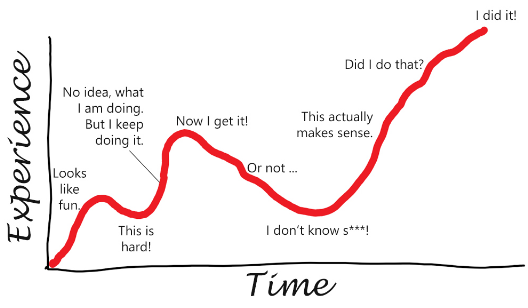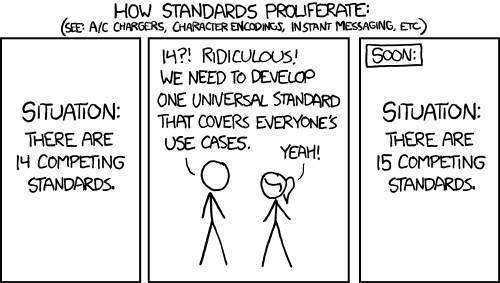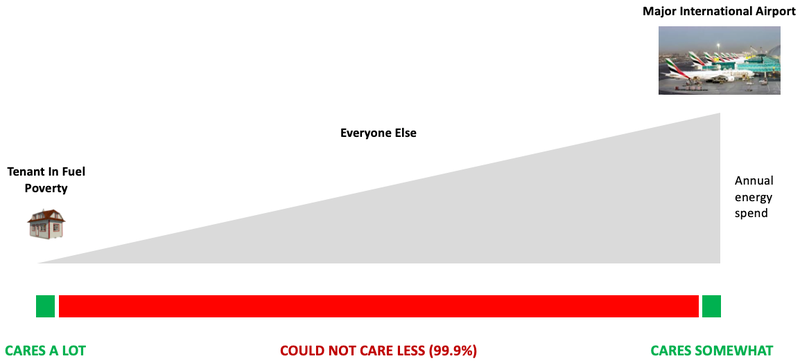
7 Key Lessons of Building Optimisation from Seven Years with Fabriq
No-one said it would be easy. But did it have to be this hard? At least it’s hard AND fun at the same time.
Here are the seven lessons of building optimisation that we learned during the years since the founding of Fabriq - so you don't have to!

Looks familiar? That’s because it’s reality. And the curve goes on like this.
1. It's the data, stupid! Always. the. data.
People outside of the building optimisation industry always find this hard to believe: even in 2018 and after more than 25 years of the advent of the consumer internet, getting good data out of buildings is still a major challenge. Even in the case of shiny new commercial buildings, most of the time we’re looking at a combination of spreadsheets, utility bills and if we’re lucky, a handful of half-hourly meters. Which goes a long way towards explaining the industry joke of Microsoft being everyone’s biggest competitor...
There is often more data available, but that’s siloed across a variety of systems from BMSs (building management systems) to submeters or gateways and individual control systems. Even if you get access to these sources - something we’ve become *exceedingly* good at - mapping the data to the right type of equipment in the building with the right multipliers etc. is often a manual process. And that takes time.
Someone should really work on a solution to automate this process. Oh wait, that's us! Can’t tell you more right now but watch this space ;)
2. We don’t need more “standards”. We need common sense and collaboration. And this thing called the Internet.
BACnet, Modbus, M-Bus, KNX, DALI, 0-10V, Bluetooth Mesh, ZigBee, Z-Wave, NB-IoT - to name but a few. Are you dizzy yet? So are we, and the rest of the industry. And that’s the people in the know - no wonder no one else wants to even deal with these things!

xkcd FTW
Granted, the “standards” above are for different types of applications (from building management systems to metering and lighting controls) and different levels of the protocol “stack”. But they’re confusing all the same. And the real problem is that you’ll have a mix of them in any single building you're trying to optimise. We know this because we’ve been there and back. Hundreds of times. Now imagine what a “smart city” looks like from a standards perspective... OK, moving on.
The good news is that there is this thing called the Internet. At protocol level we’re calling it TCP/IP. Which enables us to transfer data via standard web methods which include FTP (avoid if you can - it’s old and brittle - but no-one ever listens...), HTTP and APIs. You can also go “serverless” and communicate between services at bus-level, but that’s a different topic entirely. What matters is that 99.9% of people should never have to worry about any of the above. Rather, they should be able to plug a new piece of equipment or sensor in the building, and for it to just work. You know, like Bluetooth. Most of the time anyways.
More work to do on this front, mind. But we’re getting there. Here’s a prediction: we’ll have true IP-based plug and play in smart buildings before the Internet turns 50!
3. Technology is the easy part - 99% of the building optimisation solutions we need, are available today. Surprise surprise?
So yes, we qualify as a tech(nology) startup, and we pride ourselves in our own technology (platform, features etc.) on being best in class. But that’s not the real issue, or the answer to all our challenges. We can churn out new features, dashboards and data source integrations like there’s no tomorrow, and have done just that over that past years.
Likewise on the side of building equipment and efficiency measures - we basically already know what to do and how to do it, from double glazing to LED lighting and efficient chillers, to name but a few. But that doesn’t mean these solutions get applied at scale. Which is another lesson we had to learn.

The building on the left isn’t really smart - it only shows the key systems most (large) buildings have. But it can be smart-enabled! The building on the right by our friends over at Edge Technologies is one of the smartest in the world. But there’s way too few of them around!
4. There *is* a business case for this sort of thing. But it’s not what you think it is.
For about the first 3-4 years of this venture, we tried to argue our (business) case mostly on the basis of energy cost savings. That is and has been the standard approach in the industry and it made a lot of sense (or so we thought): we provide you with a platform to better manage your energy consumption, you save money as a result, and hey presto - we have a business case.
The only issue is, no-one really cares about energy. Yes, you’ve heard it. Repeat after us: no-one really cares about energy. In most cases anyways. Unless you’re living in fuel poverty (which are the people who really care, and there is a growing number of them sadly), or you run an airport. But even then, energy isn’t a big cost in the grand scheme of things. So arguing our business case with saving maybe 10 or 20% of something that’s already immaterial (to most) is not a good idea. Took us only a few years to realise this. You’ll thank us one day...

Hopefully you’re part of the 99.9%. Seriously.
Now, what do people care about? That’s easy - the right temperature, good air quality, human-centric lighting (yes, that’s a word), low noise and an overall pleasing and comfortable environment. You know, the basic stuff. Luckily, this is now slowly but surely understood by corporates and building designers, and we’re seeing several initiatives in the market to try to quantify the impact of this type of building optimisation in financial terms. Which, when we succeed, means we will have a business case that’s 10 or 100 times stronger than what we tried to do before.
And guess what - we’re going to use *exactly* the same platform for all of this. Fabriq already tracks any kind of environmental metrics, air quality, occupancy and so on. On top of that, it can do interactive floorplans and apps, which is what building end users really care about.
5. Ticking boxes might save your a*s, but it won’t save the planet. Sorry, not sorry :/
CSR is a good thing, make no mistake. So are the various environmental reporting and building certification standards, from GRESB and GRI to LEED, BREEAM and WELL, to name but a few. But this is only a means to an end, which *should* be more transparency, better benchmarks, more pressure to improve operations, and ultimately significantly measurable improved efficiencies and environmental impact. Yet the latter doesn’t really happen all that often, and the industry gets stuck at making sure that a constantly growing number of boxes are ticked and participants end up in the top-right quadrant of the respective charts. Nice for PR, but the planet doesn’t care.
The issue here is that there is too much focus on reporting and rankings, and too little on actual, day-by-day operational management and continuous asset improvement. As long as there isn’t a tangible and fully trackable and transparent impact on that side of things, we’re not doing our job properly as an industry.
6. Blockchain, anyone? You sure about that?
Ever found yourself in this situation recently?

You just can’t say it better than J. Adams. So I won’t try. (though who reads trade magazine ads any longer??)
If so, then you’re in good company, as that’s what 90% of people talking about blockchain experience right now (pick your side - you know which one you are on). Blockchain is a buzzword for most, fully understood by few, and definitely not the silver bullet for all.
Now, if you say you’d like to have a transparent, distributed, non-immutable record of all key building parameters, consumption readings, performance data, environmental metrics and usage, then we would agree for that to be a really good idea. And it’s eminently doable - we’ve got the tech for that, today. But just saying “blockchain” or implementing a blockchain-based database doesn’t mean that somehow magically the right data will appear in the right place and be accessible to the right people with the right controls. All the hard work from #1 through #5 still needs to be done by someone.
However, the key point here is that as we obtain more and more granular data over time and building owners, operators and users start focusing more on actual operations that certifications, it will be useful to have this sort of data framework available, and it can help to further accelerate the green building roll-out. If blockchain helps to motivate more people to think about things this way, it can only be a good thing.
7. Design thinking for the win! No, seriously. It can save us.
The last item on this list is at the same time the most basic and the most important one. It can be summed up in three bullet points:
- Who is your audience
- What do they need
- How will they consume and value it
These questions sound as simple as they’re hard to answer (read: product-market fit in the energy startup space can be hard to come by). Luckily, there is a decades-old framework that helps us work through this, and it’s something that’s already widely employed in industrial design and agile software development: Design Thinking.
Drawn in a pretty coloured chart, it looks something like this:

Don’t worry, if you do a good job, you’ll be able to exit the infinite loop at some point. (Source: Billy Loizou)
The key point here is to start with the basics, understand who you’re selling to and what value you bring to them, and then apply this across all levels of buildings (and by extension cities). So rather than focusing just with energy / sustainability professionals and solving their imminent problems, we should be thinking about the actual building end users and how we can help them be more comfortable, productive, happy and so on. Here’s another buzzword: cross-sector collaboration. Which is what is needed to do this right - including building investors, developers, contractors, architects, engineers, workplace designers and so on. If we apply this approach from the beginning and for everyone, we can do it!
The next seven years. And then some.
The key question is how quickly we as an industry are able to scale our efforts - saving the world one building at a time is nowhere near fast enough to meet any sort of energy and climate change targets, and it will take a step change to achieve a significant impact on the planet. Which is why, after all, we’re just getting started!
Here’s to the next seven years. Be good and keep fighting the good fight, wherever you are!

